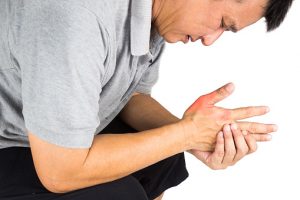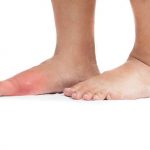
Gout has been described as a complicated type of arthritis, which affects men more often than women. It is characterized by severe pain, redness and tenderness in joints, particularly the big toe. One of the complications of gout is tophi, which are small lumps of uric acid crystals that form under the skin.
It can take several years after a first attack of gout for tophi to develop, but in some cases people develop tophi before experiencing a gout attack. While gout normally forms on the toes, heels, fingers, knees and elbows, it can in fact attack anywhere in the body, including the spinal canal and vocal chords. People who have gout with tophi can undergo uric acid-lowering therapy.
Presence of tophi in people with gout can increase risk of cardiovascular disease

The researchers took 170 participants and divided them up into four groups. The first group contained men and women with osteoarthritis but no history of gout, while the other three groups were people in various stages of developing or having gout. It is important to note that the fourth group of participants had gout with tophi. At the end of the study period the results showed the presence of tophi in gout increased the risk of cardiovascular disease. Following the study, lead doctor, Rada Gancheva, said, “These data suggest that the presence of tophi may confer an independent risk for cardiovascular disease that is commensurable and even greater than that for hypertension.”
Earlier study links gout to heart attack and stroke

The Oxford findings, which were published Rheumatology, indicated that gout patients were twice as likely to suffer a heart attack or stroke as those who did not have gout. The conclusion was that higher levels of uric acid, which leads to gout, are also a big risk factor for heart attack and stroke.
The findings suggest that there is a strong need for preventative measures when treating gout to also reduce heart attacks and stroke in patients. Currently, the majority of care for gout and gout with tophi is primary care, not extended care for increased risk of cardiovascular disease or stroke.
Staying healthy with gout
People with gout can control the condition and reduce the risk of more attacks. Taking medications as prescribed, including therapies that reduce uric acid levels if you suffer from tophi, is important. Gout is best controlled if medications are taken at the first sign of inflammation and pain. If you have gout, it is important to keep your doctor up-to-date on all medications, vitamins and supplements you are taking. As well, maintain regular visits to your physician.
In the case of gout, you really are what you consume. For example, alcohol can raise levels of uric acid in your body, so if you are prone to gout you will want to avoid alcohol. You will also want to avoid foods that are high in purine. These include, asparagus, anchovies, beef kidneys, dried beans and peas, game meats, gravy, liver, sardines, mackerel, herring, scallops, mushrooms and sweetbreads.
Although it is important to maintain a healthy weight, low carb diets that are designed for quick weight loss are not a good idea. When carbohydrate intake is too low, the body can’t completely burn its own fat, so ketones form in the bloodstream, which can increase the level of uric acid in your blood.
Treatment for tophi with gout
Many doctors currently prescribe anti-inflammatory therapies to patients suffering from gout. Research continues in an effort to develop new and better treatments. Unfortunately, in some cases, when tophi have built up, surgery is needed to remove the uric acid crystals from the joint.
While gout tends to be a condition associated with age, younger people can get it, too. Being overweight, having hypertension, eating a diet rich in meat, having poor kidney function and having a high alcohol intake are all associated factors.
It’s important to understand and recognize the signs of gout, including warmth, swelling, discoloration or tenderness in joints, and go to see a doctor. Untreated, gout can lead to serious consequences, including joint deformity, difficulty walking or using your hands, and, as we now know, it has the potential to impact cardiovascular health.